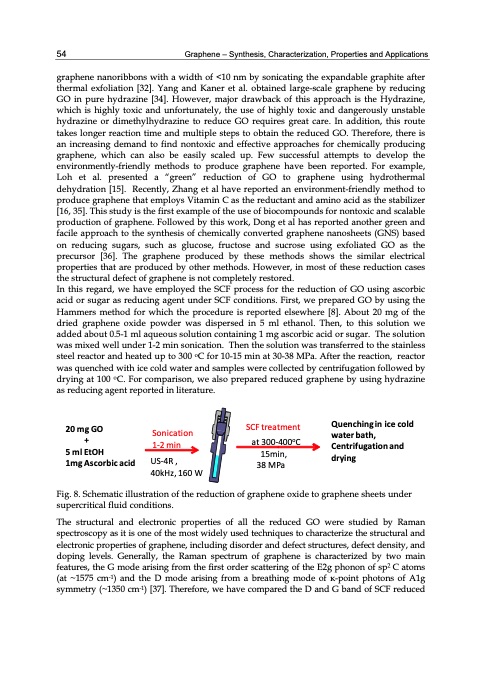
PDF Publication Title:
Text from PDF Page: 064
54 Graphene – Synthesis, Characterization, Properties and Applications graphene nanoribbons with a width of <10 nm by sonicating the expandable graphite after thermal exfoliation [32]. Yang and Kaner et al. obtained large-scale graphene by reducing GO in pure hydrazine [34]. However, major drawback of this approach is the Hydrazine, which is highly toxic and unfortunately, the use of highly toxic and dangerously unstable hydrazine or dimethylhydrazine to reduce GO requires great care. In addition, this route takes longer reaction time and multiple steps to obtain the reduced GO. Therefore, there is an increasing demand to find nontoxic and effective approaches for chemically producing graphene, which can also be easily scaled up. Few successful attempts to develop the environmently-friendly methods to produce graphene have been reported. For example, Loh et al. presented a “green” reduction of GO to graphene using hydrothermal dehydration [15]. Recently, Zhang et al have reported an environment-friendly method to produce graphene that employs Vitamin C as the reductant and amino acid as the stabilizer [16, 35]. This study is the first example of the use of biocompounds for nontoxic and scalable production of graphene. Followed by this work, Dong et al has reported another green and facile approach to the synthesis of chemically converted graphene nanosheets (GNS) based on reducing sugars, such as glucose, fructose and sucrose using exfoliated GO as the precursor [36]. The graphene produced by these methods shows the similar electrical properties that are produced by other methods. However, in most of these reduction cases the structural defect of graphene is not completely restored. In this regard, we have employed the SCF process for the reduction of GO using ascorbic acid or sugar as reducing agent under SCF conditions. First, we prepared GO by using the Hammers method for which the procedure is reported elsewhere [8]. About 20 mg of the dried graphene oxide powder was dispersed in 5 ml ethanol. Then, to this solution we added about 0.5-1 ml aqueous solution containing 1 mg ascorbic acid or sugar. The solution was mixed well under 1-2 min sonication. Then the solution was transferred to the stainless steel reactor and heated up to 300 oC for 10-15 min at 30-38 MPa. After the reaction, reactor was quenched with ice cold water and samples were collected by centrifugation followed by drying at 100 oC. For comparison, we also prepared reduced graphene by using hydrazine as reducing agent reported in literature. 20 mg GO + 5 ml EtOH 1mg Ascorbic acid Sonication 1-2 min US-4R , 40kHz, 160 W SCF treatment at 300-400oC 15min, 38 MPa Quenching in ice cold water bath, Centrifugation and drying Fig. 8. Schematic illustration of the reduction of graphene oxide to graphene sheets under supercritical fluid conditions. The structural and electronic properties of all the reduced GO were studied by Raman spectroscopy as it is one of the most widely used techniques to characterize the structural and electronic properties of graphene, including disorder and defect structures, defect density, and doping levels. Generally, the Raman spectrum of graphene is characterized by two main features, the G mode arising from the first order scattering of the E2g phonon of sp2 C atoms (at ~1575 cm-1) and the D mode arising from a breathing mode of ĸ-point photons of A1g symmetry (~1350 cm-1) [37]. Therefore, we have compared the D and G band of SCF reducedPDF Image | GRAPHENE SYNTHESIS CHARACTERIZATION PROPERTIES

PDF Search Title:
GRAPHENE SYNTHESIS CHARACTERIZATION PROPERTIESOriginal File Name Searched:
Graphene-Synthesis.pdfDIY PDF Search: Google It | Yahoo | Bing
Salgenx Redox Flow Battery Technology: Power up your energy storage game with Salgenx Salt Water Battery. With its advanced technology, the flow battery provides reliable, scalable, and sustainable energy storage for utility-scale projects. Upgrade to a Salgenx flow battery today and take control of your energy future.
| CONTACT TEL: 608-238-6001 Email: greg@infinityturbine.com | RSS | AMP |